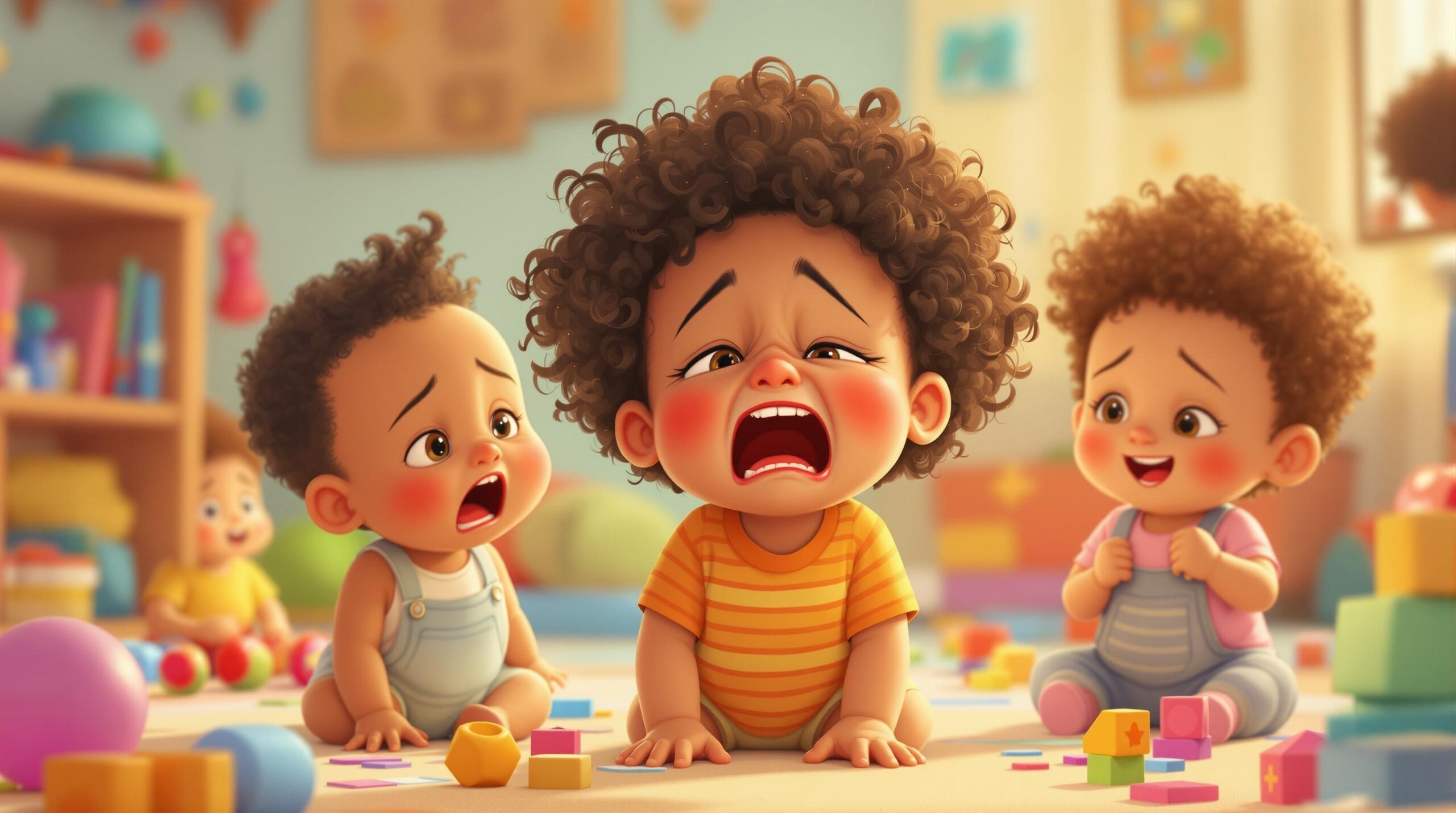Table of Contents
ToggleAs a parent, you’ve likely experienced the whirlwind of emotions that come with raising a toddler. One moment, your little one is giggling and playing happily, and the next, they’re on the floor, red-faced and screaming. Welcome to the world of toddler tantrums – a challenging yet completely normal part of child development.
The Tantrum Phenomenon: A Normal Part of Child Development
Toddler tantrums are common behavioral episodes characterized by crying, screaming, and sometimes physical outbursts. These intense emotional displays typically peak between ages 2 and 3, coinciding with a period of rapid growth and change in your child’s life. The American Academy of Pediatrics reports that nearly all children experience tantrums during their toddler years, so if you’re dealing with this, you’re certainly not alone.
Tantrums can be frustrating and even embarrassing for parents, but it’s crucial to remember that they’re a natural part of your child’s emotional and social development. These outbursts often stem from your toddler’s limited ability to express their needs and wants effectively. As your child grows and develops better communication skills, you’ll likely see a decrease in the frequency and intensity of tantrums.

Why Toddlers Have Tantrums: Understanding the Root Causes
To effectively manage tantrums, it’s essential to understand why they occur in the first place. Several factors contribute to these emotional outbursts:
Limited Verbal Skills
At around 18 months, children begin to engage in pretend play and can say several words. However, their vocabulary is still quite limited compared to their rapidly expanding understanding of the world. This gap between what they want to express and what they can actually communicate often leads to frustration. Imagine wanting something desperately but not having the words to ask for it – that’s the daily reality for many toddlers.
Developing Emotional Regulation
Toddlers are just beginning to learn how to manage their emotions, a skill that takes years to fully develop. When faced with strong feelings of anger, sadness, or disappointment, they often lack the tools to cope effectively. This inability to regulate emotions can quickly escalate into a full-blown tantrum.
Environmental Triggers
External factors can also play a significant role in triggering tantrums. These may include:
- Tiredness: An overtired toddler is more likely to have difficulty controlling their emotions.
- Hunger: Low blood sugar can lead to irritability and reduced emotional control.
- Overstimulation: Too much noise, activity, or sensory input can overwhelm a young child.
- Changes in routine: Toddlers thrive on predictability, and disruptions to their normal schedule can be upsetting.
By recognizing these triggers, you can often prevent meltdowns before they start.
The Cognitive and Social-Emotional Landscape of Toddlerhood
To better understand your toddler’s behavior, it’s helpful to consider their cognitive and social-emotional development during this stage.
Piaget’s Preoperational Stage
According to Jean Piaget’s theory of cognitive development, toddlers between 2 and 7 years old are in the preoperational stage. During this phase, children develop the ability to think symbolically and use language to represent objects and ideas. However, they still struggle with logical reasoning and often have difficulty seeing things from others’ perspectives.
Egocentric Thinking
Toddlers are naturally egocentric, meaning they have trouble understanding that others may have different thoughts, feelings, or needs than their own. This can lead to conflicts with peers and frustration when their desires aren’t immediately met.
Emerging Social Skills
Around age 2, children begin to engage in parallel play, an early stage of social interaction where they play alongside other children but not necessarily with them. They’re also starting to learn important social skills like sharing and taking turns, but mastering these concepts takes time and practice.
Understanding these developmental aspects can help you approach tantrums with empathy and patience, recognizing that your child is navigating a complex world with limited tools at their disposal.
Effective Strategies for Handling Tantrums
When faced with a tantrum, it’s essential to have a toolkit of strategies to help your child (and yourself) through the emotional storm. Here are some effective approaches:
Stay Calm and Patient
Your reaction to a tantrum can significantly influence its duration and intensity. By remaining calm, you model emotional regulation for your child and create a safe environment for them to express their feelings. Take deep breaths, speak in a low, soothing voice, and remember that this moment will pass.
Set Clear Boundaries and Consistent Rules
Establishing and maintaining clear boundaries helps provide structure and security for your toddler. Be consistent in enforcing rules, but also be willing to offer choices within those boundaries. For example, “We can’t have ice cream now, but would you like an apple or a banana for a snack?”
Offer Emotional Support and Validation
Acknowledge your child’s feelings without judgment. You might say, “I can see you’re feeling really angry right now. It’s okay to feel that way.” This validation helps your child feel understood and can often de-escalate the situation.
Research suggests that calm, responsive parenting can reduce both the frequency and intensity of tantrums over time. By consistently using these strategies, you’re not just managing individual outbursts – you’re helping your toddler develop emotional intelligence that will serve them well throughout life.
Preventing Tantrums: Proactive Approaches for Parents
While it’s impossible to eliminate tantrums entirely, there are several proactive steps you can take to reduce their likelihood:
Establish Daily Routines
Predictability can be incredibly comforting for toddlers. Create a consistent daily schedule that includes regular mealtimes, nap times, and bedtimes. This structure helps your child feel secure and reduces anxiety about what’s coming next.
Use Positive Reinforcement
Catch your child being good and praise them for it. This positive reinforcement encourages more of the behavior you want to see. Be specific in your praise, such as “I love how you shared your toy with your friend” rather than a general “Good job.”
Offer Choices
Giving your toddler age-appropriate choices can help them feel more in control and reduce power struggles. For instance, “Would you like to wear the red shirt or the blue shirt today?” Keep choices simple and limited to avoid overwhelming your child.
Practice Good Sleep Hygiene
Ensure your toddler is getting enough sleep. Overtiredness is a common trigger for tantrums. Stick to a consistent bedtime routine and make sure your child’s sleep environment is conducive to rest.
By implementing these strategies, you can create an environment that supports your child’s emotional well-being and encourages their growing independence.
When to Seek Professional Help
While tantrums are a normal part of toddler development, there are instances where professional intervention may be necessary. Consider seeking help if:
- Tantrums are extremely frequent or intense, lasting for extended periods
- Your child regularly becomes aggressive during tantrums, hitting, biting, or causing harm to themselves or others
- Tantrums significantly interfere with your child’s ability to participate in daily activities or social interactions
- You’re feeling overwhelmed or unable to cope with your child’s behavior
In these cases, don’t hesitate to consult your pediatrician. They can assess your child’s overall development and behavior, and if necessary, refer you to a child psychologist or behavioral specialist for additional support.
Remember, seeking help is a sign of strength, not weakness. Early intervention can make a significant difference in addressing behavioral concerns and supporting your child’s emotional development.
Conclusion
Toddler tantrums can be challenging, but they’re also an opportunity for growth – both for your child and for you as a parent. By understanding the root causes of tantrums, implementing effective strategies to manage them, and taking proactive steps to prevent them, you can navigate this stage of development with confidence.
Remember, every child is unique, and what works for one may not work for another. Be patient with yourself and your toddler as you figure out the best approaches for your family. With time, consistency, and lots of love, you’ll help your little one develop the emotional skills they need to thrive.
Parenting a toddler is no small feat, but with the right tools and mindset, you can turn even the toughest tantrums into valuable learning experiences for both you and your child.
Sources:
American Academy of Pediatrics: Temper Tantrums
National Institute of Child Health and Human Development: Child Development
PubMed: Development Milestones
National Institute of Child Health and Human Development: The NICHD Study of Early Child Care and Youth Development
U.S. Department of Education
Centers for Disease Control and Prevention: Positive Parenting
American Psychological Association: Tantrums
National Association for the Education of Young Children: Tantrums in Toddlers
Child Development Institute
HealthyChildren.org: Temper Tantrums












